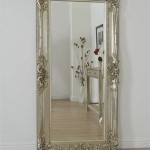How To Make A Thin Mirror Frame
Creating a thin frame for a mirror can be a fulfilling and cost-effective project. A well-crafted frame enhances the aesthetic appeal of the mirror while providing structural support. This article outlines the process of constructing a thin mirror frame, emphasizing precision and careful execution to achieve a professional-looking result.
Before commencing, gather necessary materials and tools. The choice of wood significantly impacts the final appearance. Hardwoods like maple or walnut offer durability and a refined look but are more challenging to work with. Softwoods such as pine are easier to cut and sand, making them suitable for beginners. The mirror's dimensions must be accurately measured to ensure a precise fit within the frame. Safety glasses, a dust mask, and hearing protection are essential for personal safety during the cutting and sanding processes.
Essential tools include a miter saw for accurate angle cuts, a table saw or circular saw for ripping the wood to the desired width, a measuring tape, a pencil, wood glue, clamps, sandpaper (various grits), a finishing material (paint, stain, or varnish), and a brad nailer or finish nailer (optional, but recommended for added strength).
The thickness of the wood is a critical factor in achieving a thin frame. Typically, wood with a thickness between 1/4 inch and 1/2 inch is used. The width of the frame is a matter of personal preference, but a width between 1 inch and 2 inches is common for a thin and modern aesthetic. The overall dimensions of the frame must be slightly larger than the mirror itself to allow for a small amount of play during assembly.
Accurate Measurement and Cutting
The first step involves precisely measuring the mirror. Measure the height and width of the mirror at multiple points to account for any slight variations. Add approximately 1/8 inch to 1/4 inch to each dimension. This allowance provides a small gap between the mirror and the frame, preventing undue pressure on the glass and accommodating minor imperfections in the cuts. This extra space facilitates easier insertion and removal of the mirror during the framing process.
Next, calculate the required length of each frame piece. Since a mirror frame typically consists of four pieces joined at 45-degree angles, a miter saw is used to achieve these precise cuts. A miter saw allows for consistent and accurate angle cuts, ensuring a tight and professional-looking joint. Set the miter saw to 45 degrees. Cut two pieces of wood to match the adjusted height of the mirror (mirror height plus the allowance), and two pieces to match the adjusted width. Precision in these cuts is paramount to a well-aligned frame.
When cutting, support the wood firmly to prevent splintering or inaccurate cuts. Always double-check the measurements before making the cut. It is advisable to cut slightly long initially, then make incremental cuts until the desired length is achieved. This approach minimizes the risk of cutting a piece too short, which would render it unusable. It is also crucial to ensure that the miter saw blade is sharp and properly aligned for clean cuts.
After cutting all four pieces, dry-fit them together to check for accuracy. If the corners do not align perfectly, make minor adjustments using the miter saw or a sanding block. This step is crucial for identifying and correcting any discrepancies before applying glue. Once satisfied with the fit, proceed to the next stage of assembly.
Frame Assembly and Clamping
The assembly process requires wood glue, clamps, and a clean, flat work surface. Apply a thin, even layer of wood glue to the mitered edges of each frame piece. Avoid excessive glue application, as it can squeeze out during clamping and create a mess. A small brush or spreader can be used to ensure uniform coverage.
Carefully align the corners of the frame and join the glued edges. Use clamps to hold the frame pieces securely together. Corner clamps are particularly useful for this purpose, as they apply even pressure to the mitered joints. If corner clamps are not available, use bar clamps or band clamps. Protect the frame's surface from the clamp jaws by placing pieces of wood or cardboard between the clamps and the frame.
Tighten the clamps gradually, ensuring that the corners remain aligned. Check for squareness by measuring the diagonals of the frame. If the diagonals are equal, the frame is square. If they are not equal, adjust the clamps until the frame is square. Excess glue that squeezes out from the joints should be wiped away immediately with a damp cloth.
Allow the glue to dry completely according to the manufacturer's instructions. Typically, wood glue requires at least 24 hours to cure fully. During this time, avoid moving or disturbing the frame. After the glue has dried, remove the clamps. If desired, additional reinforcement can be added to the corners using a brad nailer or finish nailer. Drive thin nails through the corners at an angle to further secure the joints. Ensure the nails are countersunk to avoid protruding above the surface.
Sanding and Finishing
After the frame is assembled and the glue has dried, the sanding process begins. Sanding smooths the surface of the wood, removes any imperfections, and prepares it for finishing. Start with a coarser grit sandpaper (e.g., 120 grit) to remove any noticeable blemishes, such as glue residue or minor scratches. Sand with the grain of the wood to avoid creating cross-grain scratches.
Progress to finer grits of sandpaper (e.g., 180 grit, then 220 grit) to refine the surface. Sanding with progressively finer grits creates a smoother and more polished finish. After sanding, remove all dust and debris from the frame using a tack cloth or a vacuum cleaner with a brush attachment. A clean surface is essential for a flawless finish.
The final step involves applying a finishing material. The choice of finish depends on the desired aesthetic. Paint provides a solid color and can be used to match the frame to the surrounding decor. Stain enhances the natural grain of the wood and adds depth. Varnish provides a protective layer and adds sheen. Before applying the finish, test it on a scrap piece of wood to ensure that it achieves the desired effect.
Apply the finish evenly using a brush, cloth, or spray applicator. Follow the manufacturer's instructions regarding application techniques and drying times. Multiple coats of finish may be necessary to achieve the desired level of protection and gloss. Allow each coat to dry completely before applying the next. Lightly sand between coats with a fine-grit sandpaper (e.g., 320 grit) to remove any imperfections and create a smooth surface for the subsequent coat. After the final coat has dried, the mirror can be inserted into the frame.
Secure the mirror within the frame using flexible tabs, mirror clips, or beads of silicone caulk. Flexible tabs are commonly used, as they are easy to install and provide a secure hold. Mirror clips are another option, but they may be more visible. Silicone caulk provides a permanent bond but can be messy to apply. Ensure that the mirror is securely held in place to prevent it from falling out of the frame.
By following these steps carefully, creating a thin mirror frame becomes an achievable and rewarding project. The resulting frame will enhance the aesthetic appeal of the mirror and add a touch of personalized craftsmanship to any space.

Antique Diy Mirror Frame Arinsolangeathome

Diy Custom Modern Bathroom Mirror Frame On A Budget
Diy Modern Mirror Re Frame What Not To Do Kayla Simone Home

Diy Wood Mirror Frame For Bathroom Vanity Tidbits

Diy Stick On Mirror Frame Sawdust Sisters

Diy Farmhouse Wood Frame Mirror She Gave It A Go

3 Ways To Frame A Mirror Wikihow

How To Easily Make A Custom Mirror Frame

Diy Wood Mirror Frame For Bathroom Vanity Tidbits

How To Build A Diy Bathroom Mirror Frame The Easy Way








